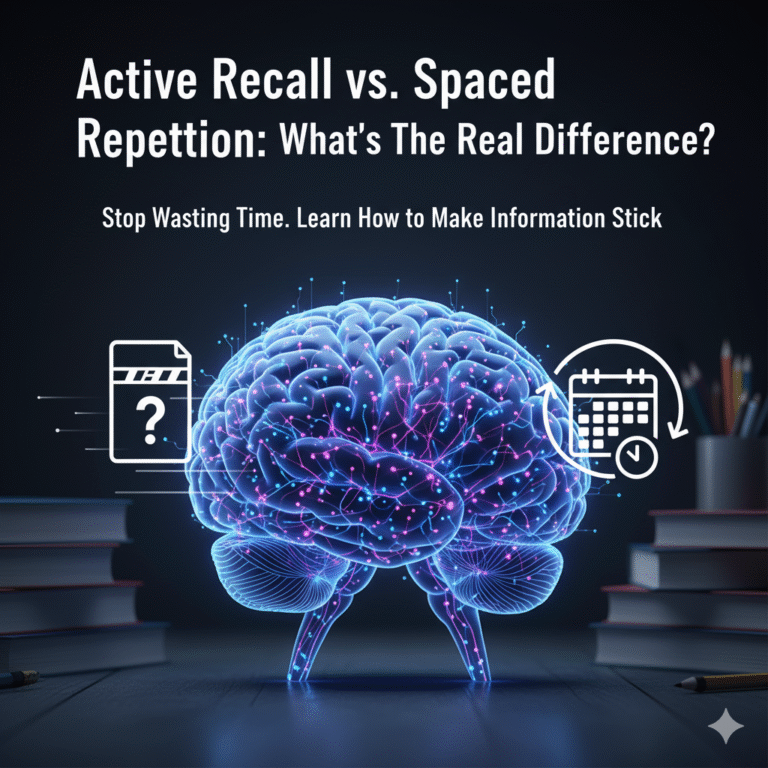How to Remember What You Read Without Taking Notes (and Actually Retain It)
How to Remember What You Read Without Taking Notes (and Actually Retain It)
Let’s be honest: you probably hate taking notes.
I get it. Your hand cramps, it’s painfully slow, and you just want to get through the chapter. You see all this advice online telling you to create detailed outlines and summaries, but you just don’t have the time or the patience.
But here’s the problem: just reading is a total waste of your time.
We’ve all done it. You sit down, highlight a few pages, get to the end, and think, “I’m done.” A day later, you’ve forgotten 90% of it.
So, if you’re going to ditch the pen, you must replace that physical work with focused mental work. This is the real secret to how to remember what you read without taking notes. You have to force your brain to stop being a passive observer and start being an active participant.
Here are the techniques that actually work.

First, Stop Just “Re-reading”
The single biggest mistake students make is re-reading their textbook. It’s the most popular, least effective study method on the planet.
Why? Because it’s passive.
It feels like work, but your brain is just glazing over the words. It tricks you with a feeling of familiarity. You see the page and think, “Yep, I remember seeing this,” but “familiar” is not the same as “understood.”
If you want to remember, you have to engage.
Technique 1: Practice Active Recall (The Look-Away Method)
This is, without question, the most powerful memory technique known to science. It’s the core of all effective studying, and it requires zero notes.
It’s simple.
- Read a small section of your book—one or two paragraphs.
- Stop. Close the book or look away from the page.
- Now, explain the main idea of that section out loud.
Seriously, out loud. If you’re in a quiet place, just mouth the words or say them in your head. You have to force your brain to retrieve the information from scratch, using its own words.
If you can’t do it? You didn’t understand it. Read that small section again and repeat the process.
This process feels slow and a bit difficult. That’s the sign that it’s working. It’s 10x more effective than passively reading the entire chapter once.
Technique 2: Explain It Like You’re Teaching a 10-Year-Old
This is a simplified version of the famous Feynman Technique.
After you read a core concept (like photosynthesis, a specific legal doctrine, or a theme in a novel), pretend you have to explain it to a child.
This forces two things to happen:
- You have to ditch all the complex jargon and use simple language.
- You have to use analogies (“So, the mitochondria is like the power plant of the cell…”).
The second you get stuck (“Wait, how does the… uh… thing connect to the…”), you’ve just found a gap in your knowledge. Go back to the book, fill that one gap, and try your simple explanation again.
Technique 3: Create Vivid Mental Movies
This one is fantastic for subjects like history, literature, or even biological processes.
As you read, actively try to visualize what’s happening. Don’t just read the words; build a movie in your head.
If you’re reading about a historical battle, picture the soldiers, the terrain, the chaos. If you’re reading about the digestive system, imagine yourself as a piece of food on that journey.
It might sound a bit silly, but these vivid, multi-sensory images are far easier for your brain to hook onto and remember than abstract text on a page.
Technique 4: Turn All Headings into Questions
This is a simple framework to stop you from “just reading.”
Before you read a new chapter, scan it first. Look at all the headings and subheadings.
Turn every single one into a question.
- If the heading is: “The Causes of the Industrial Revolution”
- Your mental question is: “Okay, what were the causes of the Industrial Revolution?”
Now, your brain is on a mission. You’re not just “reading”; you’re hunting for answers. This simple shift turns passive reading into an active search, which boosts your focus and retention dramatically.
So, How Do You Remember What You Read Without Taking Notes?
It’s not magic. It’s a shift from being a passive receiver to being an active learner.
Your brain isn’t a hard drive; you can’t just “save” information by looking at it. You have to process it.
These techniques—Active Recall, teaching the concept, and visualization—are your replacement for note-taking. They are the work that makes memory stick. Research from cognitive psychology, like the work highlighted by experts at the Learning Scientists blog, confirms that retrieval practice (like Active Recall) is far superior to simple re-reading.
A Quick, Honest Warning
I have to be real with you: this will feel harder than just reading.
Forcing your brain to retrieve information is mentally taxing. It’s supposed to be. That’s why it works.
It’s like the difference between sitting on a park bench (passive reading) and doing a set of heavy squats (active recall). The squats are what build muscle. This is how you build brain-muscle.
Many students give up and go back to their comfortable, useless highlighting. Don’t be one of them.
You don’t need a pen to build a powerful memory. You just need to be willing to do the mental work. Ditch the passive highlighting. Start forcing your brain to think, retrieve, and connect.
For a deeper dive into these methods, I’d strongly recommend checking out the free, research-backed study guides at a site like Khan Academy.
What’s your biggest challenge with reading? Do you have another “no-notes” trick that works for you? Drop it in the comments.







